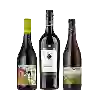
Domaine CastanSavignus Carignan
This wine generally goes well with beef and spicy food.
Wine flavors and olphactive analysis
Food and wine pairings with Savignus Carignan
Pairings that work perfectly with Savignus Carignan
Original food and wine pairings with Savignus Carignan
The Savignus Carignan of Domaine Castan matches generally quite well with dishes of beef or spicy food such as recipes of wild boar with honey or scallops with cream.
Details and technical informations about Domaine Castan's Savignus Carignan.
Discover the grape variety: Camaralet
The white Camaralet is a grape variety that originated in France (Pyrénées-Atlantiques). It produces a variety of grape specially used for wine making. It is rare to find this grape to eat on our tables. The white Camaralet can be found cultivated in these vineyards: South-West, Languedoc & Roussillon, Cognac, Bordeaux, Provence & Corsica, Rhone Valley.
Last vintages of this wine
The best vintages of Savignus Carignan from Domaine Castan are 2015, 2014, 2013
Informations about the Domaine Castan
The Domaine Castan is one of of the world's greatest estates. It offers 20 wines for sale in the of Hérault to come and discover on site or to buy online.
The wine region of Hérault
The wine region of Hérault is located in the region of Pays d'Oc of Vin de Pays of France. Wineries and vineyards like the Domaine La Grange des Pères or the Domaine La Grange des Pères produce mainly wines red, white and pink. The most planted grape varieties in the region of Hérault are Merlot, Cabernet-Sauvignon and Chardonnay, they are then used in wines in blends or as a single variety. On the nose of Hérault often reveals types of flavors of minerality, yellow apple or passion fruit and sometimes also flavors of nutty, anise or stone fruit.
The wine region of Pays d'Oc
Pays d'Oc is the PGI for red, white and rosé wines that are produced over a wide area of the southern coast of France. The PGI catchment area corresponds roughly to the Languedoc-roussillon">Languedoc-Roussillon wine region, one of the largest wine regions in France. The area covers all wines that are not produced under the strict laws that govern AOC-level appellations in the regions: among them, Corbières, Minervois and the Languedoc appellation itself. The Pays d'Oc PGI is arguably the most important in France, producing the majority of the country's PGI wines.
The word of the wine: Reduced
This is said of aromas that are reminiscent of a stale wine and that can be released when a long-closed bottle is opened. They generally fade with airing.













